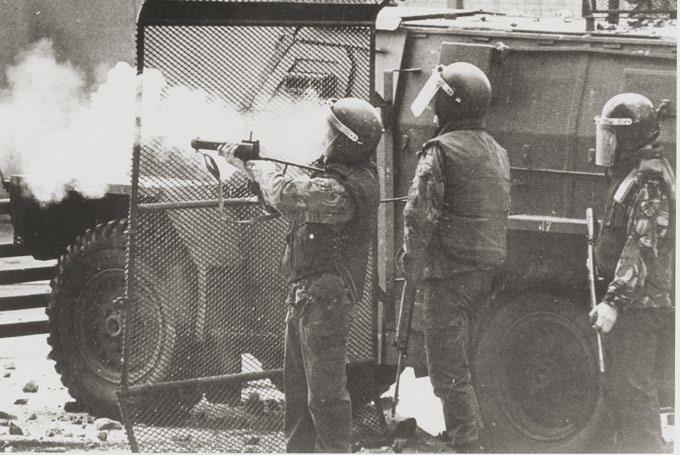
4 minute read
IN CASE OF EMERGENCY
IN CASE OF EMERGENCY: THE ARMY AND CIVIL ASSISTANCE
Crown Copyright
Advertisement
In this article, the National Army Museum examines the changing role of the British Army in providing support for civil authority – from supporting national events and helping to resolve crises, to protecting against civil threats.
Today, we trust the Army and its soldiers to help maintain vital supplies and services. We welcome them when normal civilian resources are exhausted or have broken down. And, as the 2020 coronavirus outbreak shows, we rely on them in times of national emergency.
On 19th March 2020, the Ministry of Defence announced the formation of the Covid Support Force. This was one of the measures put in place to co-ordinate Armed Forces assistance in tackling the pandemic. As part of Operation Rescript, around 20,000 military personnel were mobilised to help support public services in the UK.
On 23rd March 2020, 150 members of the Armed Forces began training at Air Products facilities in Port Talbot and Carrington to help maintain supplies of oxygen to NHS facilities. They were taught to fill oxygen tankers as well as how to drive them safely and deposit oxygen at NHS facilities. Another 700 military personnel were committed to support NHS staff at the large-scale temporary hospital at the ExCel Centre in London (NHS Nightingale), primarily to help with construction and provide logistical support.
Under the remit of Operation Broadshare, the military also assisted with repatriation flights of British citizens from China and Japan, providing medically trained personnel and a military runway for aircraft landings.
The National Army Museum is closed due to coronavirus, but its website offers access to its collections and other resources.
Visit www.nam.ac.uk to find out more.



▼ NATURAL DISASTERS In 2014 and 2015, soldiers assisted the Environment Agency in dealing with severe flooding in Hampshire and Cumbria, and have provided similar support since.
© National Army Museum
▲ 2012 OLYMPICS In 2012, the British Army drafted in over 18,000 soldiers to support the London Olympic Games when security company G4S admitted they could not provide enough guards. At the time, this was the largest peacetime domestic operation ever performed by the Armed Forces.


Crown Copyright
TERRORISM After the terrorist incident at Westminster on 22nd March 2017, police immediately assured the nation that they could call upon the Army to provide support if required.
Following the Manchester Arena bombing in May 2017, the police asked the Secretary of State for Defence to implement Operation Temperer and deploy soldiers to support its officers in protecting the public.
Working under police command, military personnel guarded key public locations, such as Buckingham Palace and the Houses of Parliament, in order to free up armed officers for patrol duties.
MAINTAINING CIVIL ORDER We see the Army’s assistance as serving society in a positive way. But this has not always been the case. There is a long history of soldiers being used to put down civil unrest or subdue public disorder on home soil. This has sometimes been controversial, especially when soldiers have turned their weapons on civilians.
Before the late 1820s, Britain had no organised police force. Troops were routinely used against smugglers and other criminals, but also against protesting and rioting civilians, sometimes with fatal results.
The late 18th and 19th centuries witnessed major social and political unrest. The Industrial Revolution caused economic distress as older trades declined and traditional social ties were eroded. Thousands of people flocked to new towns and demanded political and economic reform. In the countryside, mechanisation and enclosure led to unemployment and unrest.
Soldiers often found themselves in the unenviable position of having to deal with this discontent. ▲ THE BRISTOL RIOTS, 1831 The Bristol Riots of October 1831 took place after the House of Lords rejected the Second Reform Bill, which would have extended the franchise. Thousands of the city’s inhabitants rioted - the large crowd burned down the houses of the rich and powerful, including the Bishop’s Palace, the Custom House and the Mansion House. The mob also released prisoners from jail.
When the cavalry was called in, their commander, Lieutenant Colonel
© National Army Museum

Thomas Brereton, initially refused the order to open fire on civilians. Eventually, his force charged the crowd. Several people were killed and hundreds more wounded over three days of unrest. Over 90 protesters were sent to prison and four were hanged.
Brereton was court-martialled for negligence, taking his own life before he could be sentenced. The Mayor of Bristol and nine aldermen were prosecuted for breaching their common law ‘duty’ to assemble a force of soldiers to put down the revolt.

LEGACY The public backlash to such events means that, outside of Northern Ireland, the Army has not been used to maintain civil order in the United Kingdom since 1926. Even in Northern Ireland during The Troubles (1969-2007), the Army carefully prepared and trained for the social and legal context needed to maintain order, but still struggled to navigate the situation without controversy.
Officials now recognise that although the Army is trained in the use of force, it should only be used to control its fellow citizens as a very last resort. Instead, today’s priority during times of national crisis is to use the Army to help people in trouble – a role welcomed by society.







